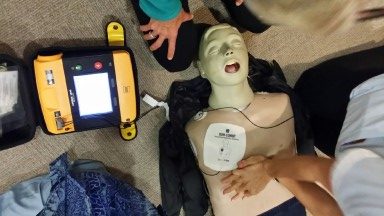Emergency Medical Training 2019 – Part 2 – Compression and Defibrillation
We are now at the CD of the DRSABCD we looked at last week. We now believe the patient has a cardiac arrest.
Compression – Get as close as you can to the patient as possible and place the palms of the hand on top of each other on the mid sternum (in between the nipples) and compress and depress firmly at 2 compressions every second. Yes it’s hard and fast i.e. 120 compressions per minute.
When working in a team count the compression and swap every 15 compressions. Use your body weight to maintain a rhythm. It is very tiring! Don’t stop and keeping going till the paramedics take over or the person becomes conscious.

Defibrillation – at Seymour Dental we have a defibrillator. If there is enough staff, the defibrillator is brought in and operated by people other than the team doing the compressions.
Clothing and bras will need to removed or cut off with scissors, and if necessary, thick body hair removed with a shaver. If hair is not removed where the pads go and a shock is delivered, the heat will burn the hair!
Right pad goes under right collar bone, above the right nipple.
Left pad goes under the left nipple around upper side of the body that is under the arm.
The Defibrillator now is able to assess the electrical activity of the heart. The machine will call out instructions. It will say “stop compressions, analysing”. It is determining if the heart rhythm is shockable. (25% of cardiac arrests are non-shockable rhythms).
Everyone keeps clear of the entire body.
Next it will say either:
- Continue compressions; or
- Keep clear, deliver shock, analysing
Compressions continue and the machine will analyse every two minutes automatically.
Don’t stop until the ambulance officers take over the compressions and equipment.

Need an Appointment?
If you’d like to book an appointment with the dentist at Seymour Dental then call us in Dulwich Hill, Sydney on (02) 9564 2397 or
contact us
Next week
Emergency Medical Training 2019 - Part 3 - Oxygen Administration